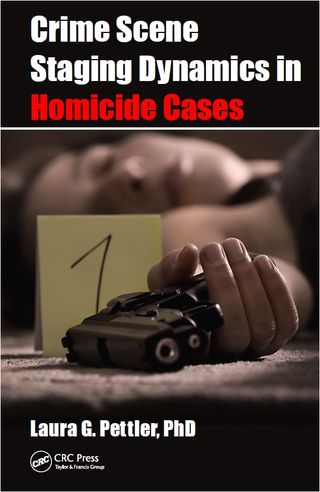Law and Crime
Staging Murder
Investigative author focuses on the art and error of homicide staging.
Posted July 17, 2016

My students often ask me what’s the perfect murder. I usually say, “The one we don’t know about.” In the age of CSI and DNA, you might have the impression that no one can get away with murder anymore, but that’s not true. Some crimes have no leads; others have deceptive leads, set up by someone trying to deflect investigators.
In 2007, Jocelyn Earnest was found in her home with a fatal gunshot to the head. The gun belonged to her ex-husband, Wesley, but he said he’d purchased it for her. He claimed she’d been despondent over the debt they shared for a large home that had lost its value in the housing market crash. Her suicide note confirmed this.
Since Jocelyn’s friends insisted she was afraid of her husband, she was not depressed, and she was texting a friend at the time she was shot, investigators looked for signs of staging. It did not take long to notice that the thermostat had been set very high, the gun lay on the wrong side of the body, Jocelyn had been moved, and she’d left her beloved dog caged and unfed. She also had no financial issues, as a judge had ordered Wesley to shoulder the house debt.
Soon, strange items surfaced about Wesley, such as borrowing a friend’s truck, changing its already new tires under a false name, and lying to associates about a number of things.
The note was the primary giveaway. Jocelyn wrote mostly by hand, yet this note was typed. It had not been typed on any computer associated with her. The sentiments expressed did not mirror the state of mind her friends, mother and therapist had experienced. The paper also bore two partial thumbprints that belonged to Wesley. He was convicted of murder. His staging had been poorly contrived.
“Crime scene staging is the physical manifestation of a person’s imagination for how things should appear when trying to turn a murder scene into a legitimate death scene,” says criminologist and death investigation consultant Laura G. Pettler, who is also vice president of the American Investigative Society of Cold Cases.
Although most crime scene processing books mention staging, Pettler’s Crime Scene Staging Dynamics in Homicide Cases focuses exclusively on the subject, especially regarding murder. She had conducted a qualitative study of 18 known staged homicides to identify the most common behaviors of crime scene stagers. She provides a methodology for identification and analysis of evidence, and has tried it out on homicides that she has helped to investigate.
Among key problems for any investigator, and the reason why staging might succeed, is the cognitive error known as threshold diagnosis, which leads to tunnel vision. That is, investigators might decide what must have happened as soon as they arrive, which tends to anchor them in their hypothesis. They fail to notice items that might discount their notions. An inconsistency, such as Jocelyn’s habit of writing by hand, can be easily minimized and dismissed.
This is why even an amateur stager can fool detectives.
Before you read about techniques in this book, you get some history, including from Shakespeare and the Bible. This is an academic book, with serious intent, not a fluffy narrative. Staging probably dates back as far as humankind’s origin, since there were usually penalties for murder. If those offenders with homicidal intent were clever enough, they might devise a way to make murder look like something else: natural, an accident, or a suicide.
Some incidents were merely staged as “the other guy did it,” as (allegedly) with Lizzie Borden. The first one described comes from the 16th century, although it seems odd that Richard Hunne’s death in a jail cell in 1514 was even called a suicide: his hands were tied behind his back. That should have been obvious at once. An investigation showed that his neck had been broken prior to the hanging. He was acquitted of the charge of self-murder. (I’m sure he was relieved.)
Pettler describes the differences between staging and scene alteration, emphasizing intent. It would be difficult to know the true statistics about how many scenes are staged, because those that fool investigators are obviously not included in a count. Pettler discusses why this is a problem. She also describes the most common characteristics and motives of offenders.
Among the staged homicides are those that include robberies, car accidents, fires, sexual assault, missing persons, and home invasions. The basis for a solid investigation is victimology, and Pettler describes this approach. Since most victims knew the offender in those crime scenes that she analyzed, she insists that a full victimology be performed.
The bottom line for her is to bring more awareness to the problem of homicide staging and the need for investigative training.
I agree. I’m working on a study of suicide notes and I’m amazed at how many death investigators have said to me, “If there’s a note, it’s a suicide.” That the scene could be staged doesn’t seem to register unless it’s obvious. Yet I have a collection of faked suicide notes from homicides. I’m willing to bet there are more out there that have been accepted as genuine.
Pettler’s comprehensive work fills a barely-noticed but significant hole in crime scene investigation. It’s a good reminder to investigators to keep perspective and look for the signals of staging. All investigators who care about their work – and about justice – should read this book. We need fewer “perfect crimes.”




